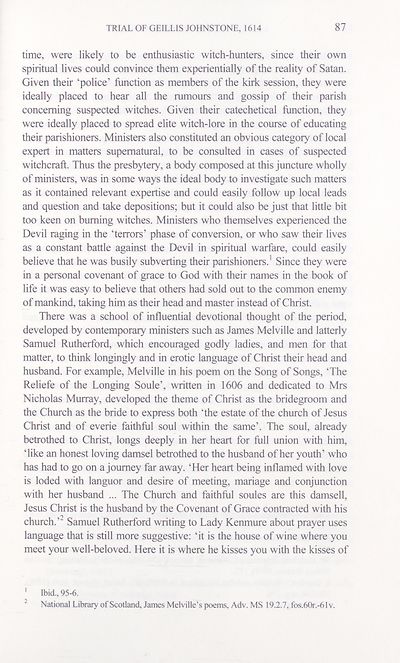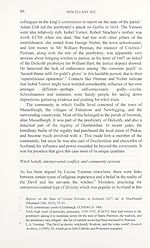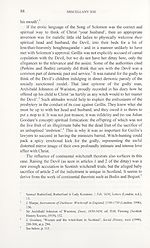Series 5 > Miscellany [of the Scottish History Society] XIII
(102) Page 87
Download files
Complete book:
Individual page:
Thumbnail gallery: Grid view | List view

TRIAL OF GEILLIS JOHNSTONE, 1614
87
time, were likely to be enthusiastic witch-hunters, since their own
spiritual lives could convince them experientially of the reality of Satan.
Given their ‘police’ function as members of the kirk session, they were
ideally placed to hear all the rumours and gossip of their parish
concerning suspected witches. Given their catechetical function, they
were ideally placed to spread elite witch-lore in the course of educating
their parishioners. Ministers also constituted an obvious category of local
expert in matters supernatural, to be consulted in cases of suspected
witchcraft. Thus the presbytery, a body composed at this juncture wholly
of ministers, was in some ways the ideal body to investigate such matters
as it contained relevant expertise and could easily follow up local leads
and question and take depositions; but it could also be just that little bit
too keen on burning witches. Ministers who themselves experienced the
Devil raging in the ‘terrors’ phase of conversion, or who saw their lives
as a constant battle against the Devil in spiritual warfare, could easily
believe that he was busily subverting their parishioners.1 Since they were
in a personal covenant of grace to God with their names in the book of
life it was easy to believe that others had sold out to the common enemy
of mankind, taking him as their head and master instead of Christ.
There was a school of influential devotional thought of the period,
developed by contemporary ministers such as James Melville and latterly
Samuel Rutherford, which encouraged godly ladies, and men for that
matter, to think longingly and in erotic language of Christ their head and
husband. For example, Melville in his poem on the Song of Songs, ‘The
Reliefe of the Longing Soule’, written in 1606 and dedicated to Mrs
Nicholas Murray, developed the theme of Christ as the bridegroom and
the Church as the bride to express both ‘the estate of the church of Jesus
Christ and of everie faithful soul within the same’. The soul, already
betrothed to Christ, longs deeply in her heart for full union with him,
Tike an honest loving damsel betrothed to the husband of her youth’ who
has had to go on a journey far away. ‘Her heart being inflamed with love
is loded with languor and desire of meeting, mariage and conjunction
with her husband ... The Church and faithful soules are this damsell,
Jesus Christ is the husband by the Covenant of Grace contracted with his
church.’2 Samuel Rutherford writing to Lady Kenmure about prayer uses
language that is still more suggestive: ‘it is the house of wine where you
meet your well-beloved. Here it is where he kisses you with the kisses of
Ibid., 95-6.
National Libraiy of Scotland, Janies Melville’s poems, Adv. MS 19.2.7, fos.60r.-61v.
87
time, were likely to be enthusiastic witch-hunters, since their own
spiritual lives could convince them experientially of the reality of Satan.
Given their ‘police’ function as members of the kirk session, they were
ideally placed to hear all the rumours and gossip of their parish
concerning suspected witches. Given their catechetical function, they
were ideally placed to spread elite witch-lore in the course of educating
their parishioners. Ministers also constituted an obvious category of local
expert in matters supernatural, to be consulted in cases of suspected
witchcraft. Thus the presbytery, a body composed at this juncture wholly
of ministers, was in some ways the ideal body to investigate such matters
as it contained relevant expertise and could easily follow up local leads
and question and take depositions; but it could also be just that little bit
too keen on burning witches. Ministers who themselves experienced the
Devil raging in the ‘terrors’ phase of conversion, or who saw their lives
as a constant battle against the Devil in spiritual warfare, could easily
believe that he was busily subverting their parishioners.1 Since they were
in a personal covenant of grace to God with their names in the book of
life it was easy to believe that others had sold out to the common enemy
of mankind, taking him as their head and master instead of Christ.
There was a school of influential devotional thought of the period,
developed by contemporary ministers such as James Melville and latterly
Samuel Rutherford, which encouraged godly ladies, and men for that
matter, to think longingly and in erotic language of Christ their head and
husband. For example, Melville in his poem on the Song of Songs, ‘The
Reliefe of the Longing Soule’, written in 1606 and dedicated to Mrs
Nicholas Murray, developed the theme of Christ as the bridegroom and
the Church as the bride to express both ‘the estate of the church of Jesus
Christ and of everie faithful soul within the same’. The soul, already
betrothed to Christ, longs deeply in her heart for full union with him,
Tike an honest loving damsel betrothed to the husband of her youth’ who
has had to go on a journey far away. ‘Her heart being inflamed with love
is loded with languor and desire of meeting, mariage and conjunction
with her husband ... The Church and faithful soules are this damsell,
Jesus Christ is the husband by the Covenant of Grace contracted with his
church.’2 Samuel Rutherford writing to Lady Kenmure about prayer uses
language that is still more suggestive: ‘it is the house of wine where you
meet your well-beloved. Here it is where he kisses you with the kisses of
Ibid., 95-6.
National Libraiy of Scotland, Janies Melville’s poems, Adv. MS 19.2.7, fos.60r.-61v.
Set display mode to:
![]() Universal Viewer |
Universal Viewer | ![]() Mirador |
Large image | Transcription
Mirador |
Large image | Transcription
Images and transcriptions on this page, including medium image downloads, may be used under the Creative Commons Attribution 4.0 International Licence unless otherwise stated. ![]()
| Scottish History Society volumes > Series 5 > Miscellany [of the Scottish History Society] XIII > (102) Page 87 |
|---|
| Permanent URL | https://digital.nls.uk/127314753 |
|---|
| Description | Over 180 volumes, published by the Scottish History Society, containing original sources on Scotland's history and people. With a wide range of subjects, the books collectively cover all periods from the 12th to 20th centuries, and reflect changing trends in Scottish history. Sources are accompanied by scholarly interpretation, references and bibliographies. Volumes are usually published annually, and more digitised volumes will be added as they become available. |
|---|


